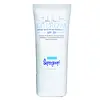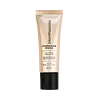Supergoop! Daily Correct CC Cream Broad Spectrum Sunscreen SPF 35 Versus bareMinerals Complexion Rescue All-Over Luminizer Mineral SPF 20
What's inside
What's inside
 Key Ingredients
Key Ingredients

 Benefits
Benefits

 Concerns
Concerns

 Ingredients Side-by-side
Ingredients Side-by-side

Titanium Dioxide 2%
Cosmetic ColorantZinc Oxide 20%
Cosmetic ColorantWater
Skin ConditioningCyclopentasiloxane
EmollientPropanediol
SolventDimethicone
EmollientIron Oxides
Lauryl PEG-9 Polydimethylsiloxyethyl Dimethicone
Skin ConditioningGlycerin
HumectantPhenoxyethanol
PreservativePyrus Malus Fruit Extract
Skin ConditioningSodium Chloride
MaskingMica
Cosmetic ColorantDimethicone/PEG-10/15 Crosspolymer
Triethoxycaprylylsilane
Silica
AbrasiveDimethicone/Vinyl Dimethicone Crosspolymer
Skin ConditioningChondrus Crispus Extract
Skin ConditioningTetrasodium EDTA
Hydrolyzed Chondrus Crispus Extract
Skin ConditioningMethylisothiazolinone
PreservativeTin Oxide
AbrasiveSodium Hyaluronate
HumectantTitanium Dioxide 2%, Zinc Oxide 20%, Water, Cyclopentasiloxane, Propanediol, Dimethicone, Iron Oxides, Lauryl PEG-9 Polydimethylsiloxyethyl Dimethicone, Glycerin, Phenoxyethanol, Pyrus Malus Fruit Extract, Sodium Chloride, Mica, Dimethicone/PEG-10/15 Crosspolymer, Triethoxycaprylylsilane, Silica, Dimethicone/Vinyl Dimethicone Crosspolymer, Chondrus Crispus Extract, Tetrasodium EDTA, Hydrolyzed Chondrus Crispus Extract, Methylisothiazolinone, Tin Oxide, Sodium Hyaluronate
Titanium Dioxide
Cosmetic ColorantWater
Skin ConditioningCoconut Alkanes
EmollientPropanediol
SolventSqualane
EmollientMica
Cosmetic ColorantTrehalose
HumectantGlycerin
HumectantSorbitan Sesquiisostearate
EmulsifyingAgar
MaskingIsostearic Acid
CleansingPolysorbate 60
EmulsifyingSilica
AbrasiveGlobularia Cordifolia Callus Culture Extract
Skin ConditioningSalicornia Herbacea Extract
Skin ConditioningMelilotus Officinalis Extract
AstringentSodium Hyaluronate
HumectantCoco-Caprylate/Caprate
EmollientAluminum Hydroxide
EmollientHydrogen Dimethicone
Polyglyceryl-4 Laurate/Succinate
Caprylic/Capric Triglyceride
MaskingButylene Glycol
HumectantLauroyl Lysine
Skin ConditioningCellulose Gum
Emulsion StabilisingCalcium Chloride
AstringentSuccinoglycan
Skin ConditioningSynthetic Fluorphlogopite
Magnesium Chloride
Potassium Chloride
Coumarin
PerfumingPotassium Sorbate
PreservativePhenoxyethanol
PreservativeIron Oxides
CI 15850
Cosmetic ColorantTitanium Dioxide, Water, Coconut Alkanes, Propanediol, Squalane, Mica, Trehalose, Glycerin, Sorbitan Sesquiisostearate, Agar, Isostearic Acid, Polysorbate 60, Silica, Globularia Cordifolia Callus Culture Extract, Salicornia Herbacea Extract, Melilotus Officinalis Extract, Sodium Hyaluronate, Coco-Caprylate/Caprate, Aluminum Hydroxide, Hydrogen Dimethicone, Polyglyceryl-4 Laurate/Succinate, Caprylic/Capric Triglyceride, Butylene Glycol, Lauroyl Lysine, Cellulose Gum, Calcium Chloride, Succinoglycan, Synthetic Fluorphlogopite, Magnesium Chloride, Potassium Chloride, Coumarin, Potassium Sorbate, Phenoxyethanol, Iron Oxides, CI 15850
Ingredients Explained
These ingredients are found in both products.
Ingredients higher up in an ingredient list are typically present in a larger amount.
Glycerin is already naturally found in your skin. It helps moisturize and protect your skin.
A study from 2016 found glycerin to be more effective as a humectant than AHAs and hyaluronic acid.
As a humectant, it helps the skin stay hydrated by pulling moisture to your skin. The low molecular weight of glycerin allows it to pull moisture into the deeper layers of your skin.
Hydrated skin improves your skin barrier; Your skin barrier helps protect against irritants and bacteria.
Glycerin has also been found to have antimicrobial and antiviral properties. Due to these properties, glycerin is often used in wound and burn treatments.
In cosmetics, glycerin is usually derived from plants such as soybean or palm. However, it can also be sourced from animals, such as tallow or animal fat.
This ingredient is organic, colorless, odorless, and non-toxic.
Glycerin is the name for this ingredient in American English. British English uses Glycerol/Glycerine.
Learn more about GlycerinMica is a naturally occurring mineral used to add shimmer and color in cosmetics. It can also help improve the texture of a product or give it an opaque, white/silver color.
Serecite is the name for very fine but ragged grains of mica.
This ingredient is often coated with metal oxides like titanium dioxide. Trace amounts of heavy metals may be found in mica, but these metals are not harmful in our personal products.
Mica has been used since prehistoric times throughout the world. Ancient Egyptian, Indian, Greek, Roman, Aztec, and Chinese civilizations have used mica.
Learn more about MicaPhenoxyethanol is a preservative that has germicide, antimicrobial, and aromatic properties. Studies show that phenoxyethanol can prevent microbial growth. By itself, it has a scent that is similar to that of a rose.
It's often used in formulations along with Caprylyl Glycol to preserve the shelf life of products.
Propanediol is an all-star ingredient. It softens, hydrates, and smooths the skin.
It’s often used to:
Propanediol is not likely to cause sensitivity and considered safe to use. It is derived from corn or petroleum with a clear color and no scent.
Learn more about PropanediolSilica, also known as silicon dioxide, is a naturally occurring mineral. It is used as a fine, spherical, and porous powder in cosmetics.
Though it has exfoliant properties, the function of silica varies depending on the product.
The unique structure of silica enhances the spreadability and adds smoothness, making it a great texture enhancer.
It is also used as an active carrier, emulsifier, and mattifier due to its ability to absorb excess oil.
In some products, tiny microneedles called spicules are made from silica or hydrolyzed sponge. When you rub them in, they lightly polish away dead skin layers and enhance the penetration of active ingredients.
Learn more about SilicaSodium Hyaluronate is hyaluronic acid's salt form. It is commonly derived from the sodium salt of hyaluronic acid.
Like hyaluronic acid, it is great at holding water and acts as a humectant. This makes it a great skin hydrating ingredient.
Sodium Hyaluronate is naturally occurring in our bodies and is mostly found in eye fluid and joints.
These are some other common types of Hyaluronic Acid:
Learn more about Sodium HyaluronateTitanium dioxide is a mineral UV filter widely used in sunscreens and cosmetics.
It is one of only two UV filters officially classified as “mineral” by regulatory agencies, the other being zinc oxide.
Titanium dioxide provides broad-spectrum protection mostly in the UVB and UVAII range, with some protection in the UVAI range.
While its UVA protection isn’t as strong as zinc oxide’s, the difference is minor.
A common myth is that mineral UV filters reflect UV light. However, modern research shows titanium dioxide absorbs UV radiation like chemical filters (~95% absorption & 5% reflection).
Thanks to its non-irritating nature, titanium dioxide is suitable for sensitive, acne-prone, or redness-prone skin. It is unlikely to cause "eye sting" like other sunscreen ingredients.
A major drawback of this ingredient is its white cast and thick texture. This is why mineral sunscreens often leave a white cast and are less cosmetically elegant than chemical/hybrid sunscreens.
To improve white cast and spreadability, micronized or nano-sized titanium dioxide is often used.
There are ongoing concerns surrounding nano-titanium oxide's impact on marine ecosystems.
There is no conclusive evidence that any form of titanium oxide (or any other sunscreen ingredients) will cause harm to marine ecosystems or coral reefs. The science is still developing but many consumers are keeping a close eye on this issue.
Please note, many destinations have reef-safety sunscreen rules. For instance, the U.S. Virgin Islands advises all visitors to use non-nano mineral sunscreens.
Nano mineral sunscreens once raised safety concerns about absorption into skin.
Extensive research has shown that they do not penetrate healthy or damaged skin; they remain safely on the surface and the top layer of dead skin (stratum corneum).
You'll likely find titanium dioxide bundled with alumina, silica, or dimethicone. These ingredients help make titanium dioxide highly photostable; this prevents it from interacting with other formula components under UV light.
Learn more about Titanium DioxideWater. It's the most common cosmetic ingredient of all. You'll usually see it at the top of ingredient lists, meaning that it makes up the largest part of the product.
So why is it so popular? Water most often acts as a solvent - this means that it helps dissolve other ingredients into the formulation.
You'll also recognize water as that liquid we all need to stay alive. If you see this, drink a glass of water. Stay hydrated!
Learn more about WaterThis ingredient is a combination of red, black, and yellow iron oxide pigments. This combination of colors is usually found in foundation, because it results in a "skin" color.